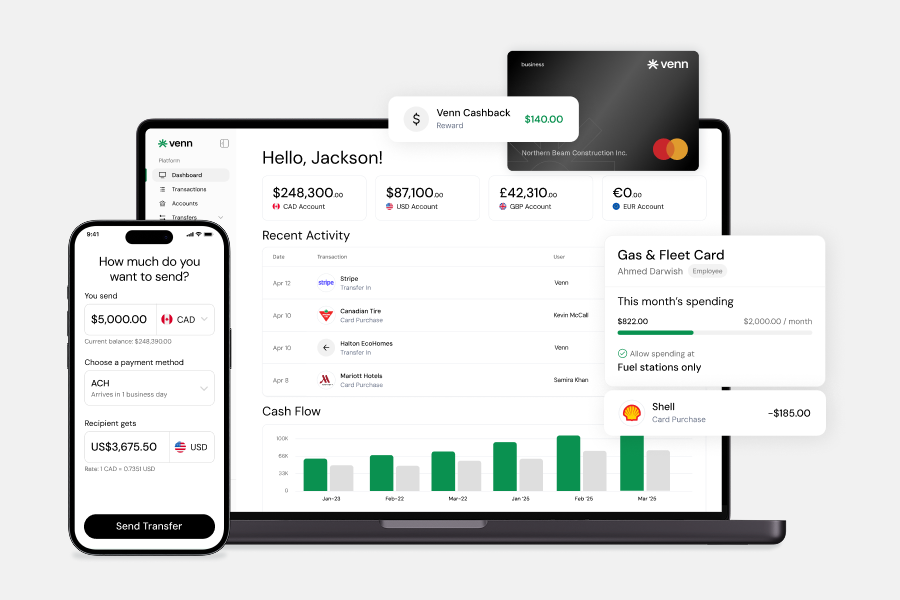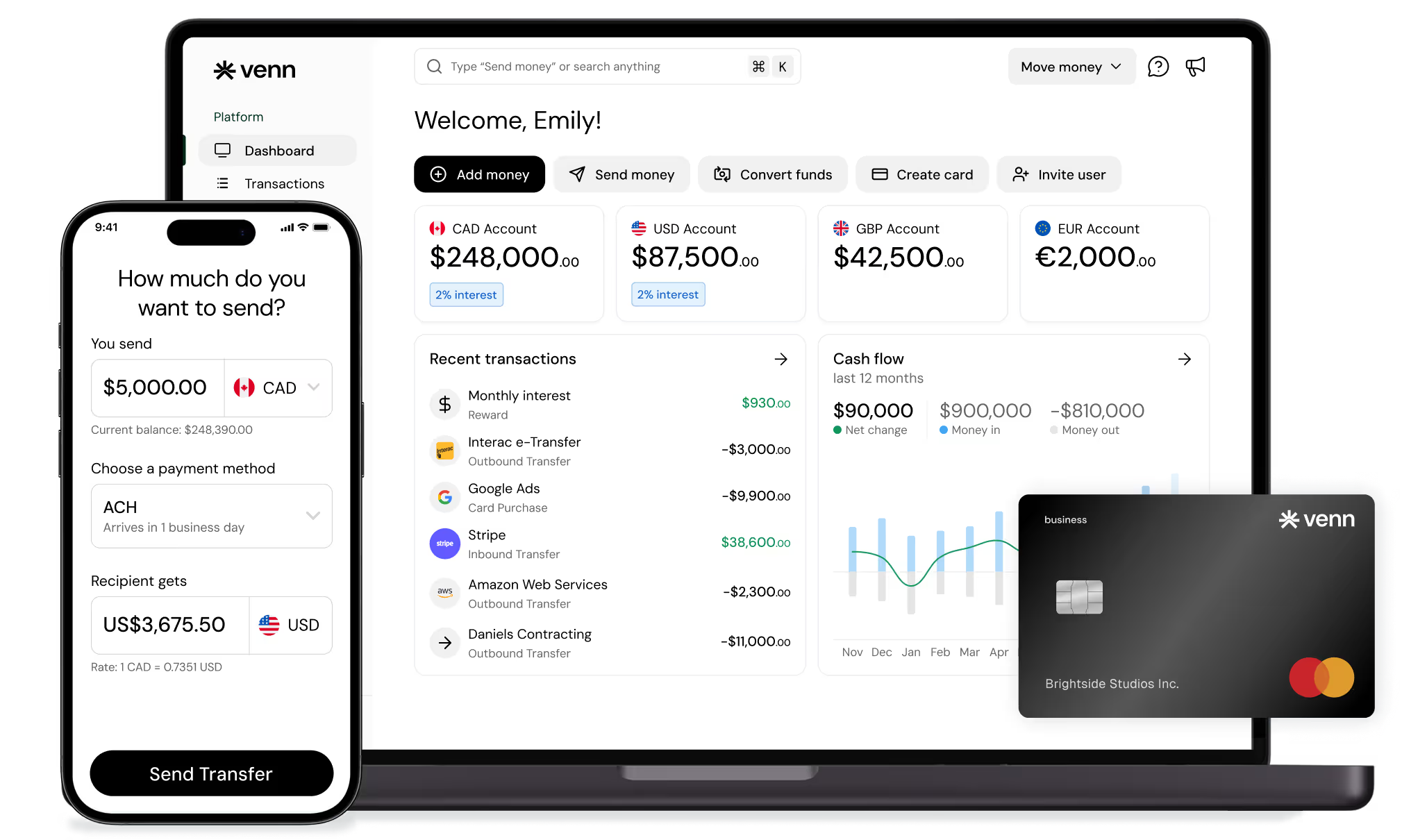Important Accounting Formulas for Businesses: Main Formulas to Know
What do every small business, Fortune 500 companies, and weekend side hustles have in common? They know their numbers.


Trusted by 5,000+ Canadian businesses
Business banking for Canada
Local CAD and USD accounts, corporate cards with cashback, the lowest FX rates in Canada, free local transfers, and more.
There’s a reason why every accountant and smart business owner lives by accounting formulas. The main Accounting Formula, more commonly known as the Accounting Equation, is the foundation of financial accounting. It ensures financial balance, keeps your financial statements aligned, and helps you understand your business’s financial health.
This main formula is represented as:
Assets = Liabilities + Equity.
Let’s break down the key components of the accounting formula, how it works, and how tools like Venn make it easier to apply in real time. Plus, we’ll cover other essential accounting equations to better manage your finances.
Breakdown of the Basic Accounting Formula
The accounting equation is what helps businesses maintain balance, transparency, and reliability when managing their finances.
To help you reconcile financial statements and confirm financial accuracy with ease, let’s break down the three parts of the accounting formula.
- Assets: What your business owns, e.g., cash, inventory, equipment, property, and more.
- Liabilities: What your business owes, e.g., loans, accounts payable, and expenses.
- Equity: What’s left after liabilities are paid. This is the owner’s stake in the company.
Let’s say we want to know a company’s overall financial health. According to Apple’s quarterly financial report published in January 2025, the company's total assets and liabilities amount to $344,085.00 and $277,327.00, respectively.
Equity = Assets - Liabilities
= $344,085.00 - $277,327.00
= $66,758.00
This number represents Apple’s financial position relative to its debts, based on its publicly available balance sheet.
The more numbers, the easier it is to make mistakes. Financial platforms like Venn help maintain this balance automatically by syncing transactions to accounting software, thereby reducing errors that can skew your balance sheet.
Other Important Accounting Formulas
The basic accounting formula is the starting point, but not the only formula you should know. Let’s go over other key accounting equations:
1. Profitability Formulas
The gross profit formula, the operating profit formula, and the net profit formula help you see how much money your business actually makes.
- Gross Profit Formula: Revenue - Cost of Goods Sold (COGS) = Gross Profit
- The gross profit is your revenue minus the direct costs of producing goods or services, which indicates the basic or first level of profitability.
- Operating Profit Formula: Revenue - Cost of Goods Sold (COGS) - Operating Expenses - Depreciation & Amortisation = Operating Profit
- The operating profit is your gross profit minus your operating expenses, including rent, salaries, utilities, and other day-to-day expenses. This also includes accounting costs, such as amortisation and depreciation.
- Net Profit Formula: Revenue - All Expenses = Net Profit
- The net profit is the profit remaining after all expenses, including operating costs, COGs, interest, and taxes, have been subtracted from revenue. If you earned $80,000 in income and had $50,000 in expenses, your net profit is $30,000.
2. Liquidity Formulas
Liquidity ratios indicate whether your business can cover its short-term obligations using its available assets. These numbers help in budget preparation, so you’re not caught off guard by unexpected expenses or tight cash flow.
To ensure liquidity, use the following formulas:
- Current Ratio Formula: Current Assets / Current Liabilities = Current Ratio
- The current ratio is the simplest way to see if you can afford to pay short-term bills. If you have $20,000 in assets and $10,000 in liabilities, your current ratio is 2. That means you can pay your bills twice over.
- Quick Ratio (Acid Test) Formula: (Cash + Accounts Receivables + Marketable Securities) / Current Liabilities = Quick Ratio
- The quick ratio is similar to the current ratio, but is more detailed, with a greater emphasis on liquid assets, including cash, accounts receivable, and marketable securities.
3. Solvency Formulas
Unlike liquidity ratios that deal with short-term obligations, solvency ratios evaluate whether your company can meet its long-term obligations.
- Debt to Equity Ratio (D/E) Formula: Debt Outstanding / Equity = Debt to Equity Ratio
- The debt-to-equity ratio indicates the balance between what your business owes and what it actually owns. A high ratio indicates higher financial risk. Debt outstanding includes both short-term and long-term debts, as well as fixed payments.
- Interest Coverage Ratio (ICR) Formula: Earnings before interest and taxes (EBIT) / Interest Expenses = Interest Coverage Ratio
- The interest coverage ratio indicates whether you can comfortably make your interest payments. If a company has an EBIT of $1,000,000 and interest expense of $200,000, its ICR would be 5. This means the company can cover its interest expense five times over with its current earnings.
To further evaluate your company’s financial health, also consider bad debt expenses. Bad debt expenses refer to the amounts that customers owe to the business but are unlikely to be collected.
Learn how to calculate bad debts here.
4. Efficiency Formulas
Efficiency ratios show how well your business uses resources to generate revenue. A high ratio means that you’re using your assets effectively.
- Inventory Turnover Formula: Cost of Goods Sold (COGS) / Average Inventory = Inventory Turnover Ratio
- The inventory turnover ratio helps you see how quickly you're selling and replacing your inventory. A low inventory turnover ratio may indicate that sales are slow or that there’s excessive unsold inventory.
- Accounts Receivable Turnover Formula: Net Credit Sales / Average Accounts Receivable = Accounts Receivable Ratio
- Accounts receivable are sales made now, paid later using credit. Net credit sales are the total sales your business made on credit. Dividing the two determines how many times, on average, your business converts that credit to cash. Low ratios mean that your customers are unlikely to pay on time.
5. Market Value Formulas
Market value helps you understand what your company is worth from the perspective of investors. This is especially important if you're looking to raise capital or attract buyers.
- Earnings Per Share (EPS) Formula: (Net Income - Preferred Dividends) / Weighted Average Shares Outstanding (WASO) = EPS
- The EPS tells investors how profitable your business is per share. Preferred dividends are the payments sent to your preferred shareholders. WASO is the average number of shares of your company in circulation. The higher your EPS, the more value each share brings.
- Price-to-Earnings (P/E) Ratio Formula: Market Value per Share / Earnings per Share (EPS) = P/E Ratio
- The P/E ratio helps investors decide if a stock is overvalued or undervalued. It’s great for benchmarking your company’s value against others. For example, FedEx’s current stock price is at $237.90 as of July 24, 2025, with an EPS of $16.82. FDX’s P/E ratio is 14.14, which means investors are willing to pay $14.14 for every $1 of earnings.
You can also use a discounted cash flow (DCF) calculator to assess the present value of your company's future cash flows. It helps determine whether your company’s stock is overvalued or undervalued, and provides investors with insight into your business’s long-term value.
Accounting Formula vs. Cash Flow Statement
Both the accounting formula and the cash flow statement help you understand your business’s financial performance, but they are two different terms.
- Accounting formula: Shows what your business owns, what it owes, and how much belongs to you or your shareholders.
- Cash flow statement: Tracks how cash moves in and out of your business.
Let’s say your balance sheet shows a healthy equity position, but your cash flow statement shows you’re running low on cash. The accounting formula helps you evaluate profitability, while a cash flow statement calculator lets you know if you’re generating enough money to pay bills and keep operating.
Together, they give you a reliable and comprehensive view of your company’s financial position.
Simplify Your Business Finances with Venn
With numerous formulas to monitor your financial performance, Venn makes it easy to apply these formulas in practice, ensuring your assets, liabilities, and equity remain in balance.
- Real-Time Two-Way Sync: Venn syncs with accounting platforms like QuickBooks and Xero to eliminate the need for manual reconciliation, ensuring your books reflect real-time changes.
- Categorisation and Spend Visibility: Venn tags and categorises every transaction in line with your chart of accounts, supporting financial reporting across departments.
- Multi-Currency Accounting: Venn handles CAD, USD, GBP, and EUR with no manual conversions. Send, receive, and hold funds with transparent FX rates from 0.25%.
- Eliminating Errors from Manual Inputs: Venn automates your entire spend and accounting flow to reduce formula mismatches and closing delays.
Venn ensures your accounting remains accurate and actionable across all your financial operations. No more manual patchwork and no end-of-month scrambles for your business.
Key Takeaways:
- The accounting formula is a fundamental tool for financial analysis. It helps balance your books and represents the financial health of your business.
- Knowing other formulas, such as those for profitability, liquidity, solvency, efficiency, and market value, turns operational performance into measurable financial indicators, helping you identify which areas need improvement.
- Venn allows you to automate everything, from reconciliation to multi-currency accounting to ensure your financial data remains accurate and up-to-date.
Make the Numbers Work for You With Venn
Mastering the accounting formula is just the beginning. Venn gives you the power to automate reconciliation, track spending in real time, and streamline financial reporting, all from one intuitive platform.
Stop patching together spreadsheets and start making informed decisions with confidence.

Frequently Asked Questions (FAQs)
Q: What happens if the accounting equation doesn’t balance?
If the accounting equation (Assets = Liabilities + Equity) does not balance, it is a clear indication of a bookkeeping error. This typically means a transaction wasn't recorded properly, was duplicated, or was omitted entirely (e.g., recording the debit side but forgetting the credit side in a double-entry system).
Q: What are the common mistakes in using the accounting formula?
Common mistakes when applying the accounting formula include: overlooking unrecorded liabilities (like accrued expenses), misclassifying assets (e.g., treating a current asset as non-current), or failing to properly update equity changes (such as owner withdrawals or retained earnings adjustments). Avoiding these requires maintaining detailed source documents, verifying account classifications regularly, and reconciling all accounts on a scheduled basis.
Q: What tools help track assets, liabilities, and equity?
Modern accounting tools and platforms are essential for accurately tracking the components of the accounting equation. Software like QuickBooks Online, Xero, and integrated financial solutions like Venn automatically use the double-entry system to record and sync data. These tools reduce manual human error, categorize transactions correctly, and provide real-time financial visibility into the balances of assets, liabilities, and equity.
Q: Who uses the accounting equation?
The accounting equation is the foundational principle used by virtually all financial stakeholders. Accountants and bookkeepers use it daily to record transactions and ensure the accuracy of financial statements. Business owners and financial analysts use it for financial reporting, budgeting, and auditing to confirm that all company transactions align with proper accounting principles.
Venn is all-in-one business banking built for Canada
From free local CAD/USD accounts and team cards to the cheapest FX and global payments—Venn gives Canadian businesses everything they need to move money smarter. Join 5,000+ businesses today.

Frequently asked questions
Everything you need to know about the product and billing.
Venn is the cheapest and easiest way to manage your business banking needs. We offer the best currency exchange rates in Canada, chequing accounts in multiple currencies, domestic and international bank transfers, and a corporate Mastercard to manage all your spend. By signing up to Venn you automatically get:
- Accounts in Canadian dollars, US dollars, British pounds, and Euros
- The cheapest FX rates in Canada with free domestic transfers (EFT, ACH, SEPA, FPS)
- A Mastercard Corporate card that gets you the same great FX rates and cashback with no minimum spend requirements
Yes, Venn holds eligible deposits at our Partner Institution in our trust accounts, including deposits in foreign currencies. CDIC protects eligible deposits up to CA$100,000 per deposit category per CDIC member institution.
No, we don’t have any hidden fees! All charges, including currency conversion and premium plans, are clear and transparent. You can even issue unlimited corporate cards to your team and sign up with a free plan in minutes! Learn more about our transparent Pricing.
Nope! Other companies and traditional bank accounts have high minimum balance requirements. This makes accounts inaccessible for small businesses or individuals. Venn does not require a minimum balance. Your CAD and USD funds will also earn 2% interest regardless of the balance.
Our process is quick — Customers typically get set up in 5 minutes or less! Create a free account and start saving with no monthly fees, cashback on card spend, and the best FX rates around.
Of course! Our friendly Support specialists are available via Chat or Email 24 hours a day, 7 days a week, 365 days a year. All tickets are monitored and responded to within 24 hours, with an average response time of 30 minutes.
Yes, we have a direct integration with QBO and Xero. We are working on more integrations very soon!
Join 5,000+ businesses banking with Venn today
Streamline your business banking and save on your spend and transfers today
No personal credit check or guarantee.


